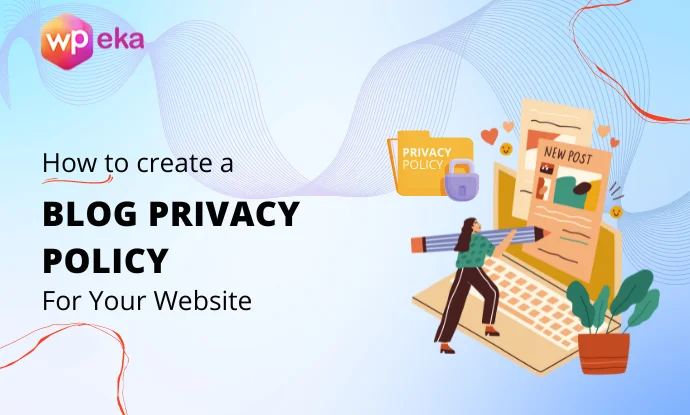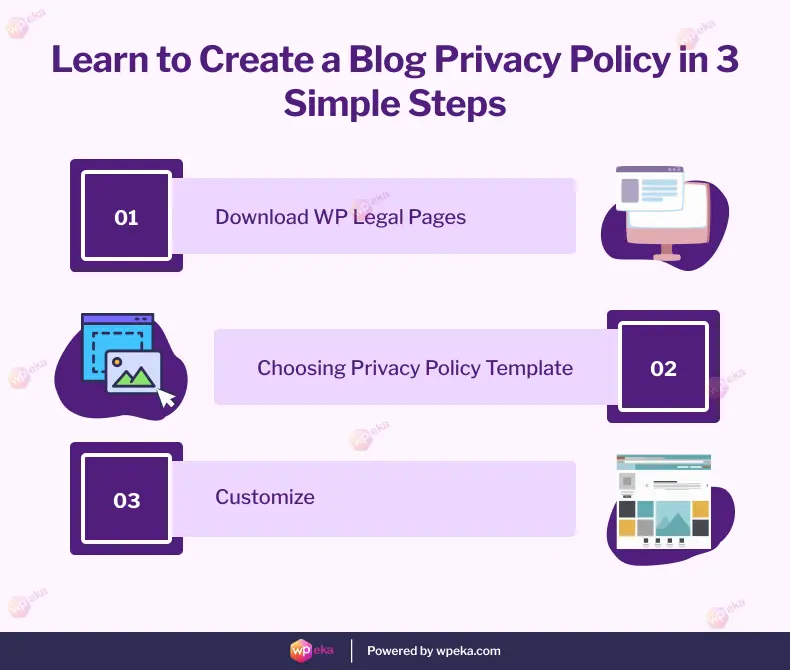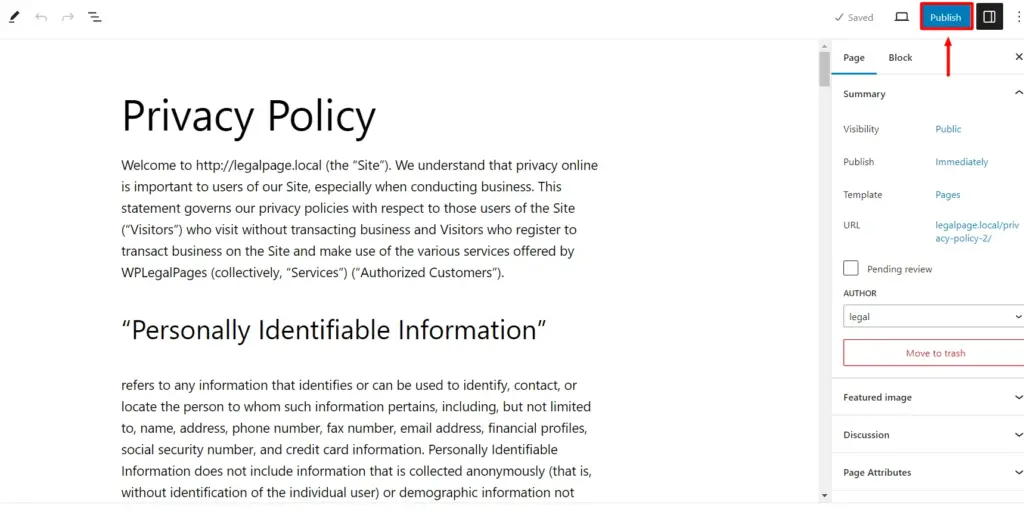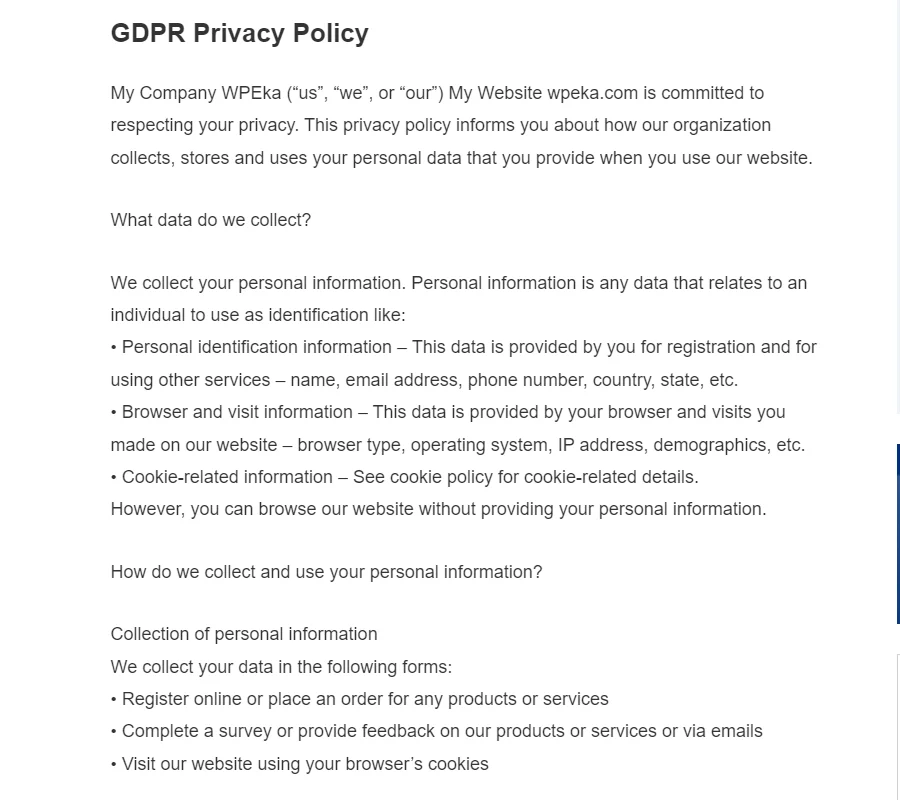How To Create A Blog Privacy Policy? – A Beginner’s Guide

Are you a blogger looking to create a blog privacy policy?
Look no further! This article will help you understand all the essentials of creating a privacy policy for a blog website.
Creating a privacy policy for your blog is essential. It helps establish trust with your readers and ensures compliance with data protection regulations. In addition, it also communicates to your audience how their personal information is collected, used, and protected when they visit your blog.
However, creating a privacy policy for your site is not very easy, as it involves a lot of legal technicalities. This blog will break down the key requirements which you must know while creating privacy policy for a blog website.
So, without further ado, let’s dive in.
What Is A Blog Privacy Policy
A blog privacy policy is an important legal document that outlines how your website collects, stores, uses, shares, and tracks users’ personal information. It also entails informing users of their data privacy rights and how to exercise them.
If a website is collecting any personal information of users, including names, email addresses, phone numbers, ip addresses, or transactional details, it is a must for them to display privacy policy on their website to comply with global laws.
Do You Need a Privacy Policy for Your Blog Website?
Yes, you need a privacy policy for your blog if you collect personal data from your users.
It is a legal requirement and a crucial step in building trust with your audience. This shows your readers that you take their privacy seriously and provides transparency about how you manage their data.
Furthermore, let’s discuss in detail why you must have a privacy policy on your blog.
1. Ensures Legal Compliance
Global privacy policy laws such as the General Data Protection Regulation (GDPR), California Consumer Protection Act (CCPA), and others ensure the safety of individuals’ privacy policies. These legal regulations ensure that if your website collects users’ data, you must have a privacy policy on your page. Failing to do so can lead to penalties and legal complications.
2. Maintains Transparency
A clearly drafted privacy policy also helps you maintain transparency with your users. It demonstrates to your users how you value their privacy by informing them of your methods of data collection, security measures to safeguard data, purpose of data collection and sharing, and tracking information. This can lead to increased engagement and building a positive reputation.
3. Protects Users Rights
The privacy policy also outlines users’ rights in detail. It mentions the users’ rights to access data, request corrections, or request deletion. It also provides information on how users can exercise these rights. This helps users protect their rights and privacy.
4. Complies With Terms Of Third-Party Services
Third-party services, such as analytics tools, advertising networks, email marketing platforms, or social networking plugins, might require a privacy policy in order to comply with their terms of service. These services typically entail the collecting and processing of user data; thus, they require assurance that you will educate your consumers about these practices.
4. Mitigates Legal Risks
A clear and comprehensive privacy policy can help you avoid legal risks and potential lawsuits. If your website gets involved in any privacy issue, having a well-documented privacy policy might show that you took steps to educate your visitors about your data practices.
Global Privacy Laws Affecting Blog Websites
Now that you know what a blog privacy policy is and why you must have it on your website, Let’s learn about global privacy policy laws affecting blog websites.
With the rising concerns of data theft and fraud, various steps have been taken to ensure data safety. Various global privacy laws have been enacted in different parts of the world to safeguard users’ right to privacy.
California Consumer Protection Act (CCPA)
The California Consumer Privacy Act (CCPA) is a state act that strengthens privacy rights for residents of California. It has an impact on global privacy laws regulating blog websites by requiring businesses that collect personal information from California residents to disclose the purpose of data collection, allow consumers to opt out of the sale of their personal information, and provide mechanisms for consumers to request access to and deletion of their data. The CCPA also restricts the acquisition of data from children and requires enterprises to use appropriate security measures.
General Data Privacy Regulation (GDPR)
The General Data Protection Policy (GDPR) is a comprehensive EU policy that significantly impacts global privacy policy for blog websites. It requires websites that collect or process the personal data of EU residents to get users’ consent. Further, it requires websites to establish transparent privacy policies and grant users the right to access, edit, and remove data. It also compels the establishment of data and security measures to safeguard users data.
Personal Information Protection and Electronic Documents Act (PIPEDA)
The Personal Information Protection and Electronic Documents Act (PIPEDA) is a Canadian privacy regulation with global implications. It restricts businesses and websites that collect, utilize, and disclose personal information when conducting commercial activities. The act requires consent for collecting, using, and sharing personal information and establishes clear and understandable privacy rules.
The General Data Protection Law (LGPD)
The General Data Protection Law (LGPD) is a comprehensive Brazilian privacy policy regulation that has a worldwide impact. It regulates how personal data is processed in Brazil. It mandates that websites secure personal data, offer transparent privacy policies, obtain permission before collecting data, and grant them access to view, update, and remove their data.
Check out this compliance platform comparison page, which will help you choose the best plugin for creating various compliant legal pages on your website.
What to Include in Your Blog Privacy Policy
When creating your blog’s privacy policy, there are some essential points that you must include to ensure transparency and adherence to relevant regulations.
Introduction
You must start the privacy policy with an introduction that explains the purpose of the privacy policy and how it applies to your blog.
Data Collected
The privacy policy must clearly outline the types of data you collect from visitors. This may include personal information such as names, email addresses, or any other personal information. It must also inform about any other data collected through cookies or analytics tools.
How Data is Collected
The privacy policy statement should describe how you collect data from visitors, whether it’s through contact forms, comments, cookies, or other tracking technologies.
Purpose of Data Collection
The purpose of the data collected from the users must be explained clearly. This could include purposes such as improving the user experience, sending newsletters or updates, or analyzing website traffic.
Information about the Use of Cookies and Tracking
If your website use cookies or other tracking technologies this information must be clearly disclosed and explain how these technologies are used.
Third-Party Services
If your website is integrated with any third-party services, such as analytics tools or advertising networks that collect visitor data, the information must be disclosed, and links to their privacy policies must be provided.
Data Sharing
Explain if and how you share visitor data with third parties. This could include sharing data with service providers, advertisers, or other partners.
Data Security Measures
The policy statement should utline the security measures you have in place to protect visitor data from unauthorized access, disclosure, or misuse.
User Rights
Your blog’s privacy policy must inform visitors about their rights regarding their personal data, such as the right to access, correct, or delete their information.
Policy Updates
Explain how you will notify visitors of any changes to your privacy policy and when those changes will take effect.
Contact Information
Finally you should also provide contact information for visitors to reach out with any questions or concerns about your privacy practices.
How to Create a Blog Privacy Policy

Creating a privacy policy for your blog website is a tedious task. However, using a privacy policy generator simplifies it.
A privacy policy generator is a tool that automatically creates customized privacy policy statements for users based on users’ requirements.
While many privacy policy generators are available, we recommend you use the WP Legal Pages plugin. It is a free privacy policy generator that allows you to custom-create a blog’s privacy policy tailored specifically for your business.
The plugin is very simple to use and supports an intuitive wizard that helps you to design a privacy policy template from start to finish.
All you need to do is download the plugin and sign up. Next, the wizard will walk you through a questionnaire to help you create a blog privacy policy.
Furthermore, it allows you to develop policy templates in various languages, including English, French, German, Portuguese, Italian, and others.
Steps To Create A Privacy Policy For Your Website
To generate a privacy policy for your real estate website, follow the following steps:
1. Installing The WP Legal Pages Plugin
Navigate over your WordPress Dashboard and click on Plugins > Add New.

Search for WPLegalPages in the search bar.

Click on the Install Now Button.

Click on the Activate button and activate the plugin.

Once the plugin is active, you can directly access it from your WordPress Dashboard.

2. Creating a Privacy Policy For Your Real Estate Website
From your Dashboard, click WPLegalPages and click Accept to create your legal pages.

To create a Privacy Policy for your website, click Create Legal Page from the WP Legal Pages menu.

You will now be able to see four templates available in the free version. Click on the Standard Privacy Policy option to create a Privacy policy for real estate website.

Fill in the Basic Details and click Next.

Select the appropriate section for your legal policy, then click Next.

Your Privacy Policy Template Preview is ready.

3. Customize your Privacy Policy
Click on the Create and Edit option to edit or add any additional information to your privacy policy.

After you have made the necessary changes, click on Publish.

This is how you can easily generate a privacy policy for your blog website.
Sample Privacy Policy for Blog
Check out the sample privacy policy of WPEka.

The WP Legal Pages can help you build a similar privacy policy page.
Where Should You Display Your Blog Privacy Policy?
Your blog privacy policy should be prominently displayed in accessible areas on your website. Ideally, you should include a link to your privacy policy in the footer of your website so that it appears on every page. This is a common and easily accessible location for important legal information.
You can also consider adding a direct link to your privacy policy in the website’s main navigation menu. This ensures that visitors can quickly locate it when browsing your site. Furthermore, If your blog includes collecting data through registration or contact forms, you can consider including a link to the privacy policy near these forms to inform users.
Your blog’s privacy policy should include details about the information you collect from visitors, the purpose of data, consent procedures, data security measures, third-party sharing, cookie usage, user rights, policy updates, contact information, and legal compliance.
Yes, creating a privacy policy for your blog website is necessary if it collects any personal or non-personal information from users.
Yes, you can use a free privacy policy generator to create a blog privacy policy. We recommend you to use the WP Legal Pages Plugin to create a blog privacy policy. It is a free, user-friendly plugin that guides you to create a privacy policy for your website.
Conclusion
Overall, creating a privacy policy on your blog website is crucial. It not only safeguards your business and website from legal risks but also helps to gain users’ confidence.
This article has covered all the essentials you should know if you are creating a blog privacy policy.
Also, it is recommended to try the WP Legal Pages Plugin when you build your blog privacy policy.
If you liked this article, you can also consider reading:


Leave a Reply